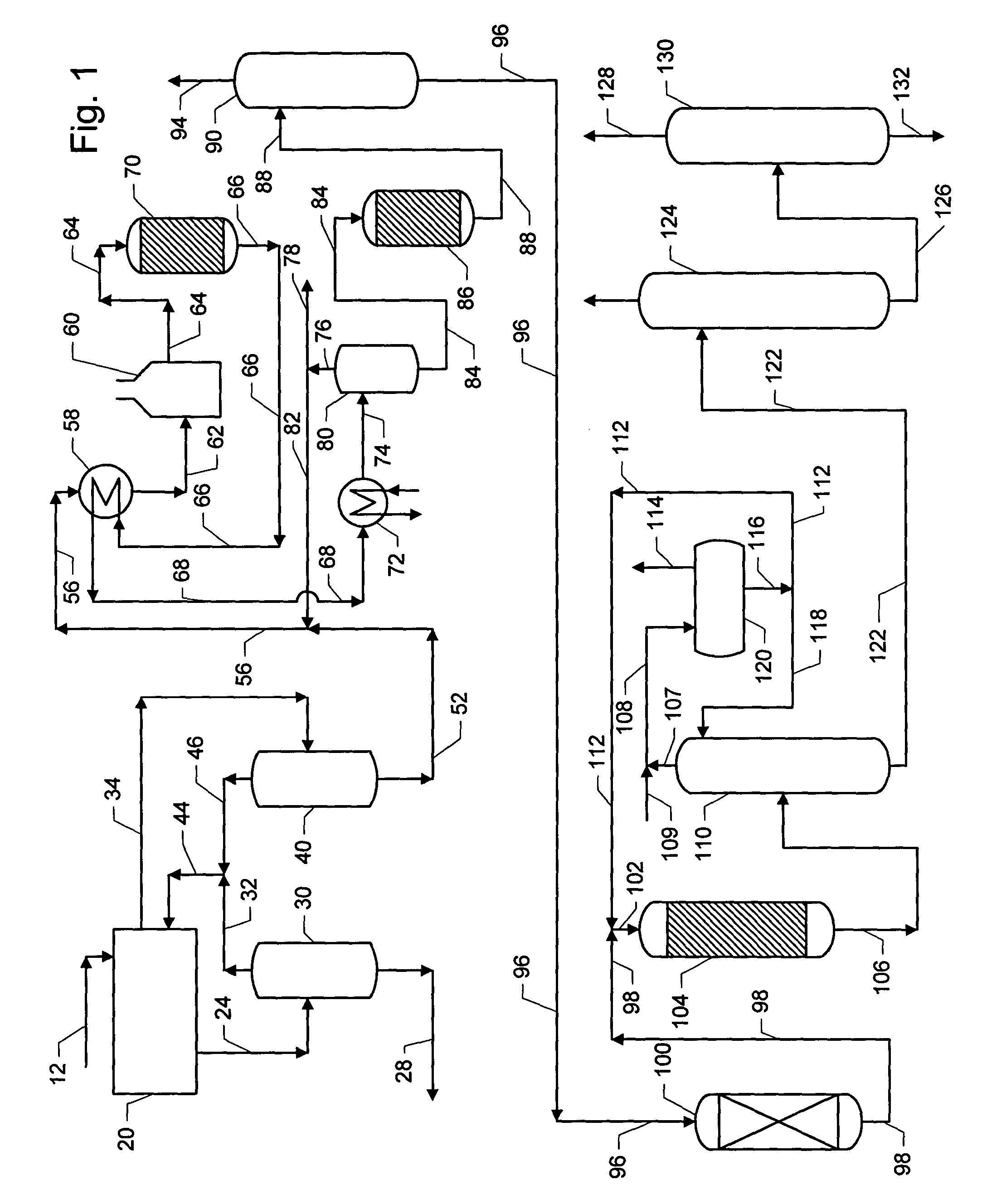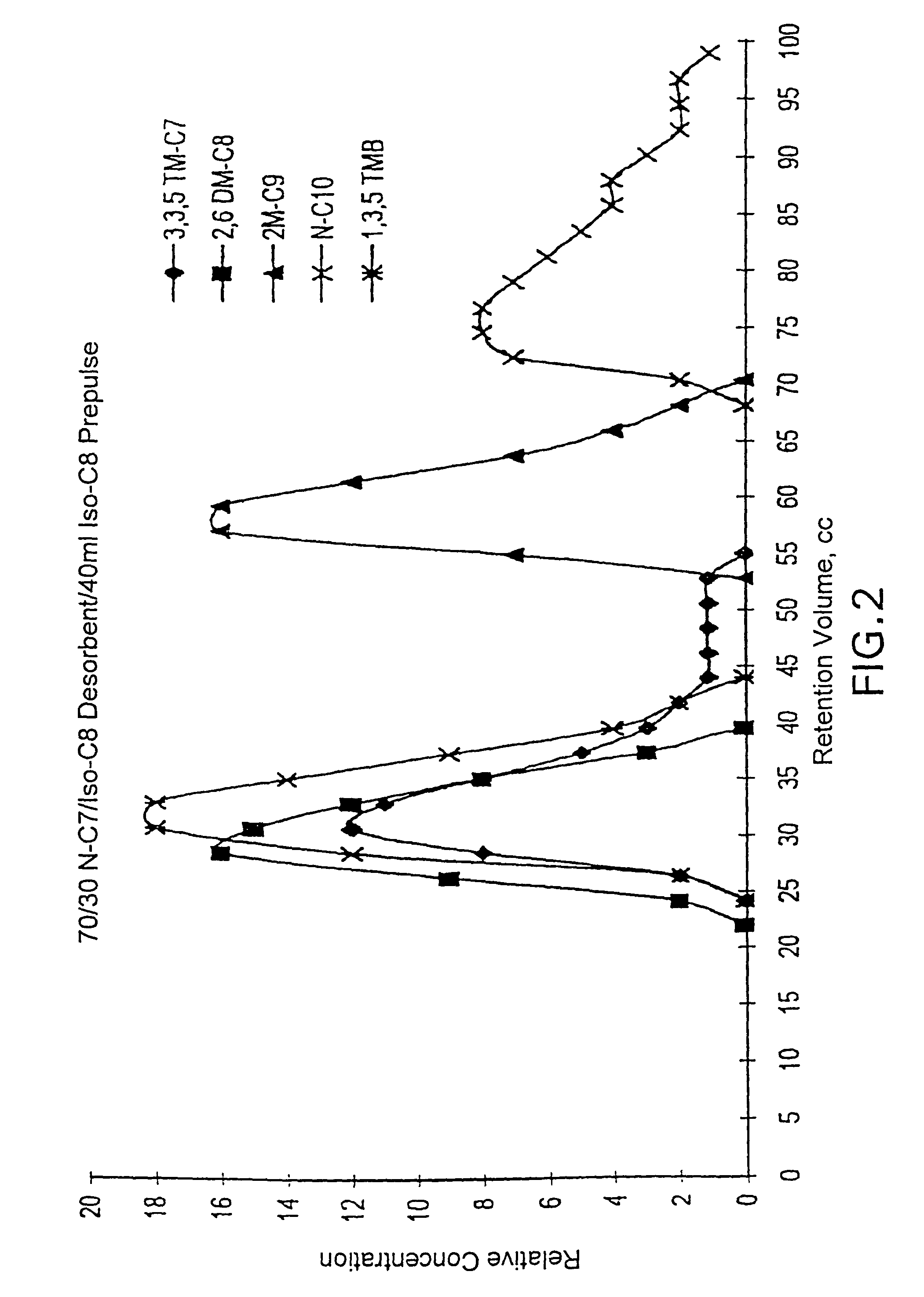Phenyl-alkane compositions produced using an adsorptive separation section
a technology of phenylalkane and composition, which is applied in the direction of hydrocarbon purification/separation, chemistry apparatus and processes, organic chemistry, etc., can solve the problems of phenyl-alkanes that are found, household laundry detergents made of babs, and gradually polluting rivers and lakes, etc., to improve the cleaning effect in hard and/or cold water
- Summary
- Abstract
- Description
- Claims
- Application Information
AI Technical Summary
Benefits of technology
Problems solved by technology
Method used
Image
Examples
example 1
[0120]A “pulse test” procedure may be employed to test adsorbents with a particular feed mixture and desorbent material to measure such adsorbent characteristics as adsorptive capacity, selectivity, resolution and exchange rate. The basic pulse test apparatus consists of a tubular adsorbent chamber of approximately 70 cc volume having an inlet and outlet at opposite ends of the chamber. The chamber is contained within a temperature control means and pressure control equipment is used to maintain the chamber at a constant predetermined pressure. Quantitative and qualitative analytical equipment such as refractometers, polarimeters and chromatographs can be attached to an outlet line of the chamber and used to detect quantitatively and / or determine qualitatively one or more components in the effluent stream leaving the adsorbent chamber. During a pulse test, the adsorbent is first filled to equilibrium with a particular desorbent material by passing the desorbent material through the ...
example 2
[0132]In this example, a representative mixture of C10 pure components was subjected to a pulse test procedure with the use of a pre-pulse of C8 isoparaffin. In the test, the feed mixture was a mixture containing equal volumes of 3,3,5-trimethylheptane, 2,6-dimethyloctane, 2-methylnonane, normal decane, and 1,3,5-trimethylbenzene. The pulse test column had a volume of 70 cc and was held at a temperature of 120° C. (248° F.). The flow rate through the column was 1.1 cc / min. The adsorbent was silicalite and the desorbent was a 70 / 30 volume % mixture of normal heptane and isooctane. The test was run with a pre-pulse of 40 ml of isooctane injected into the test loop immediately before the feed mixture was injected.
[0133]A graphical representation of the results of this test run is shown as FIG. 2. FIG. 2 shows a plot of the relative concentrations of the components versus time, as measured by the volume of collected effluent. FIG. 2 shows a useful separation between the monomethyl paraf...
example 3
[0134]An olefinic stream comprising a blend of monomethyl C12 olefins and having the composition shown in Table 5 was used.
[0135]
TABLE 5Composition of Olefinic StreamOlefin ComponentContent (wt-%)Lights10.64Linear olefins230.116-methyl undecene7.665-methyl undecene15.334-methyl undecene11.823-methyl undecene12.952-methyl undecene8.87Other alkyl olefins39.05Heavies43.53Total1001Lights include olefins having fewer than 12 carbon atoms.2Linear olefins include C12 linear olefins.3Other alkyl olefins include dimethyl, trimethyl, and other C12 olefins4Heavies include C12 olefin dimers and trimers.
[0136]The olefinic stream was mixed with benzene to produce a combined stream consisting of 93.3 wt-% benzene and 6.7 wt-% olefinic stream, which corresponds to a molar ratio of benzene per olefin of about 30:1. A cylindrical reactor, which has an inside diameter of 0.875 in (22.2 mm), was loaded with 75 cc (53.0 g) of a mordenite-alumina extruded catalyst prepared from the hydrogen form of a mor...
PUM
| Property | Measurement | Unit |
|---|---|---|
| temperature | aaaaa | aaaaa |
| temperature | aaaaa | aaaaa |
| temperature | aaaaa | aaaaa |
Abstract
Description
Claims
Application Information
 Login to View More
Login to View More - R&D
- Intellectual Property
- Life Sciences
- Materials
- Tech Scout
- Unparalleled Data Quality
- Higher Quality Content
- 60% Fewer Hallucinations
Browse by: Latest US Patents, China's latest patents, Technical Efficacy Thesaurus, Application Domain, Technology Topic, Popular Technical Reports.
© 2025 PatSnap. All rights reserved.Legal|Privacy policy|Modern Slavery Act Transparency Statement|Sitemap|About US| Contact US: help@patsnap.com



